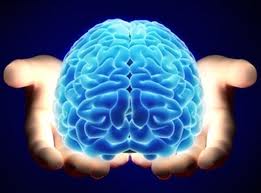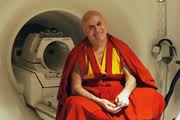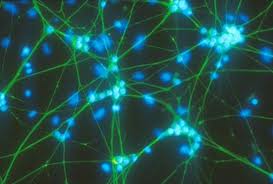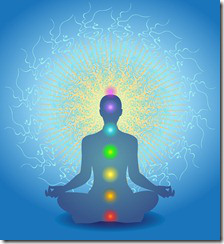
The current revolution in neuroscience is reshaping the way we see the world. Just as Darwin changed the way we thought about our origins, new research is altering our understanding of brain function and its effect on human behaviour.
Brain research has long focused on disease and disorder, but now neuroscientists are looking at what nurtures us - and what we can do to train our brains to support human flourishing.
Positive Emotions
Social interaction has a profound effect on our emotional states. Economic models have always assumed that humans are basically selfish and altruistic acts are made under social pressure, but new neuroimaging studies from Yale and Harvard on brain activity in the orbitofrontal cortex show that altruistic actions are neurally linked to the reward circuitry in the brain – that is, they are rewarding in themselves. This explains why altruistic actions have been shown to increase happiness more than selfish ones and further suggests that we may have an innate preference for fairness and equity.(1)
The emotion circuitry of the brain is complex, involving structures in the prefrontal cortex, amygdala, hippocampus and other regions. Many studies shows that positive emotions can shift brain activity from the right to the left prefrontal cortex with profound consequences for mood and behavior. For example, people with greater left brain activation are more resilient than others; they recover more quickly from adversity and are less likely to develop post-traumatic stress disorder or depression.(2)
 Positive emotions do not only support resilience. "Research has shown that positive emotions and interventions can bolster health, achievement, and resilience, and can buffer against depression and anxiety," says Professor Martin Seligman, founder of positive psychology at the University of Pennsylvania. (3) Moreover, positive emotions can be learned through coping skills training, cognitive behavior therapy and through meditation.(4)
Positive emotions do not only support resilience. "Research has shown that positive emotions and interventions can bolster health, achievement, and resilience, and can buffer against depression and anxiety," says Professor Martin Seligman, founder of positive psychology at the University of Pennsylvania. (3) Moreover, positive emotions can be learned through coping skills training, cognitive behavior therapy and through meditation.(4)
Richard Davidson, professor of Psychology and Psychiatry at the University of Wisconsin–Madison, explains further:
“The amazing fact is that through mental activity alone we can intentionally change our own brains. Mental activity ranging from meditation to cognitive behavior therapy can alter brain function in specific circuits, with the result that you can develop a broader awareness of social signals, a deeper sensitivity to your own feelings and bodily sensations, and a more consistently positive outlook. In short, through mental training you can alter your patterns of brain activity and the very structure of your brain in a way that will change your emotional style and improve your life.”(5)
Body Basics

The medical benefits of meditation, including chanting, are well known. Many studies show that meditation can help with insomnia, heart disease, psoriasis and managing chronic pain.(6)
Dr Alan Watkins, a neuroscientist at Imperial College London, found that chanting slows the heart rate and lowers blood pressure. Stress-related conditions such as asthma and rheumatoid arthritis also benefit from meditation. Just listening to chanting voices can normalize cholesterol and adrenalin levels and reduces stress levels.(7)
Dr Marian Diamond at the University of California also found that chanting helps block the release of stress hormones as well as increasing immune function.(8)
When monks at a Benedictine monastery in France became ill and lethargic after reducing the number of hours they performed Gregorian chants, Dr A. Tomatis at the French Academy of Science and Medicine found they revived when the amount of chanting was increased. He believes there are certain vibration-frequencies, not always recognizable to human consciousness, which feed and recharge the brain.(9)
The Human Brain
Neuroscientist Richard Davidson believes meditation can alter both the structure and the function of the human brain. He reasons that if meditation changes our brain circuits it must be possible to make neurally inspired behavioural interventions; that is, if we can change brain function through training, we can train ourselves out of emotional responses like depression and other patterns that are no longer helpful and retrain ourselves into better ways of thinking and being.(10)
Dr Dan Siegel of UCLA Medical School explains that the right and left hemispheres of the brain process information differently; the right hemisphere focuses more on emotional, non-verbal and spatial functions while the left hemisphere is analytical and focuses more on language, concepts and time.
“There are probably left hemisphere and right-hemisphere forms of consciousness that are quite distinct from each other, based on the unique nature of the representational process of each hemisphere,” says Siegel.(11)
The two sides of our brain are engaged in ‘cross-talk’ which is not always harmonious, Siegel says, and practices like yoga, tai chi, prayer and Buddhist meditation can help the brain to become more integrated.(12)
Moreover, when we learn to intentionally focus attention through Buddhist meditation rather than allow automatic behaviour, we activate a different brain circuitry, in other words, when we meditate, the brain is re-wiring itself.
Monk in a MRI Machine
 Richard Davidson and Antoine Lutz recently persuaded a French-born Tibetan monk, Mathieu Ricard, who has more than 30 years of Buddhist practice, to allow his brain to be scanned while he meditated. As John Geirland for Wired reports:
Richard Davidson and Antoine Lutz recently persuaded a French-born Tibetan monk, Mathieu Ricard, who has more than 30 years of Buddhist practice, to allow his brain to be scanned while he meditated. As John Geirland for Wired reports:
“Lutz immediately noticed powerful gamma activity - brain waves oscillating at roughly 40 cycles per second - indicating intensely focused thought. Gamma waves are usually weak and difficult to see. Those emanating from Ricard were easily visible, even in the raw EEG output. Moreover, oscillations from various parts of the cortex were synchronized, a phenomenon that sometimes occurs in patients under anesthesia.
The researchers had never seen anything like it. Worried that something might be wrong with their equipment or methods, they brought in more monks, as well as a control group of college students inexperienced in meditation. The monks produced gamma waves that were 30 times as strong as the students'. In addition, larger areas of the meditators' brains were active, particularly in the left prefrontal cortex, the part of the brain responsible for positive emotions.”(13)
Davidson found that people who meditate show more left-brain hemisphere dominance, which is linked to feelings such as enthusiasm, energy and joy. Increased activity in the right prefrontal area is associated with feelings of distress, sadness and worry. By training our brains to increase activity in the left prefrontal area, we can shift our moods and control our emotional balance.
“Essentially when you spend a lot of time meditating, the brain shows a pattern of feeling safe in the world and more comfortable in approaching people and situations, and less vigilant and afraid, which is more associated with the right hemisphere," says Emiliana Simon-Thomas, science director at UC Berkeley.(14)
Compassion
 Feeling safe seems to be a precondition to activating biological systems that promote compassion, explains Simon-Thomas. Concern for others only comes into play when threat systems like fear and distress aren’t the center of attention. Helen Weng at the University of Wisconsin and many other researchers (15) have found that meditation calms the amygdala, which is linked to fear and our fight-or-flight response.
Feeling safe seems to be a precondition to activating biological systems that promote compassion, explains Simon-Thomas. Concern for others only comes into play when threat systems like fear and distress aren’t the center of attention. Helen Weng at the University of Wisconsin and many other researchers (15) have found that meditation calms the amygdala, which is linked to fear and our fight-or-flight response.
UCLA psychologist and former Buddhist monk Lopsang Rapgay explains:
“In anxiety, we narrow our focus on the perceived threat. The visual-processing portion of our brain focuses on the threat and sends signals to the amygdala, our brain’s ‘fight or flight’ response center. Training the mind to broaden that narrow focus and see the world from a wider perspective lessens fear and anxiety.”(16)
Further studies by Richard Davidson and Tania Singer at the Max Planck Institute in Germany show that meditation changes the brain in measurable ways and that we can train our brains to be more compassionate.
Both experienced meditators and individuals who had never meditated were shown videos of other people suffering. fMRI brain scans showed increased brain activity in regions associated with nurture and social interaction in the experienced meditators while the non-mediators showed heightened activity in brain areas linked to distress and pain. After training, however,the new meditators’ brain activity was similar to the experienced meditators indicating that we can intentionally train our brains to be less focused on the self and more concerned about others.(17)
Me, You and Us
 In his study on Gregorian chanting, Dr Alan Watkins of Imperial College London found that chanting helps us to connect better with people around us, especially when practised in a group. People who meditate or chant together, he found, shows signs of ‘entrainment’ in their brain activity. Entrainment is the concept in natural sciences that allows fireflies to light up at the same time or birds to move in a flock. In human behavior, it describes how brainwave frequencies tend to synchronize with other frequencies in the environment, especially when there is a rhythmic stimulus.
In his study on Gregorian chanting, Dr Alan Watkins of Imperial College London found that chanting helps us to connect better with people around us, especially when practised in a group. People who meditate or chant together, he found, shows signs of ‘entrainment’ in their brain activity. Entrainment is the concept in natural sciences that allows fireflies to light up at the same time or birds to move in a flock. In human behavior, it describes how brainwave frequencies tend to synchronize with other frequencies in the environment, especially when there is a rhythmic stimulus.
Mirror neurons are another important discovery describing how the barriers between the self and others are dissolved. Dr Dan Siegel explains:
“Certain neurons can fire when someone communicates with you. They dissolve the border between you and others. These mirror neurons are a hardwired system designed for us to see the mind state of another person. That means we can learn easily to dance, but also to empathize with another. They automatically and spontaneously pick up information about the intentions and feelings of those around us, creating emotional resonance and behavioral imitation as they connect our internal state with those around us, even without the participation of our conscious mind.” (18)
In the Mode
Judson Brewer, a psychiatrist at Yale University used fMRI scans to observe the brains of meditators and found that experienced meditators had less activity in an area of the brain known as the default mode network (the medial prefrontal and posterior cingulate cortex) which is linked to self-centered thinking. Bill Hathaway of Yale News explains:
“The scans also showed that when the default mode network was active, brain regions associated with self-monitoring and cognitive control were co-activated in experienced meditators but not novices. This may indicate that meditators are constantly monitoring and suppressing the emergence of “me” thoughts, or mind-wandering.”(19)
People who meditate were able to switch off this default mode area and appeared to develop a new default mode less centered on the self which also contributed to the feeling of being unified with something larger.
 Transcendence
Transcendence
Andrew Newberg of the University of Pennsylvania is another neuroscientist who believes that brain regions can be trained and strengthened. Positive spiritual belief, prayer and meditation practice like chanting can permanently change structures and functions in the brain, altering our perception of reality.(20)
Newberg used a brain imaging technique to scan Buddhist monks in a deep trance. By injecting a tiny amount of radioactive dye into the bloodstream of a meditator, he was able to track activity in the brain. Like other researchers, he also saw increased activity in the frontal lobe, the area that directs the mind's focus, while the amygdala, the brain region related to fear, was calmed.
He also saw decreased activity in the left frontal parietal lobes, a region known to control spatial orientation, supporting evidence that meditation leads to a lack of spatial awareness and feelings of detachment and transcendence.
"During meditation, people have a loss of the sense of self and frequently experience a sense of no space and time and that was exactly what we saw," Dr Newberg explains.
"When people have spiritual experiences they feel they become one with the universe and lose their sense of self," he says. "We think that may be because of what is happening in that area; if you block that area you lose that boundary between the self and the rest of the world. In doing so you ultimately wind up in a universal state."(21)
This new wave of research suggests that humans are neurologically equipped to experience elevated spiritual states and some commentators believe we will see an increasing overlap between the core tenants of neuroscience and of Buddhism.
Daisaku Ikeda, president of the lay Buddhist movement Soka Gakkai International (SGI), writes:
“While controlling your mind, which is at once both extremely subtle and solemnly profound, you should strive to elevate your faith with freshness and vigor. When you do so, both your life and your surroundings will open wide before you, and every action you take will become a source of benefit. Understanding the subtle workings of one’s mind is the key to faith and to attaining Buddhahood in this lifetime.”(22)
Written by Geraldine Royds-Betz.
References:
1. http://www.pnas.org/content/108/49/19761.short
2. http://www.du.edu/psychology/people/mcrae.htm
3.www.templeton.org http://www.posneuroscience.org
4. Understanding Resilience Frontiers in Behavioural Neuroscience. February 2013. http://www.frontiersin.org/Behavioral_Neuroscience/10.3389/fnbeh.2013.00010/abstract
5. http://cambridgewellbeing.org/Files/UNSW_Huppert_Chapter.pdf and http://richardjdavidson.com/
6. http://www.alzheimersprevention.org/JrnlofNucMedComms0909.pdf
7. http://www.ted.com/tedx/events/2560http://www.complete-coherence.com/in-the-news/
8. http://ib.berkeley.edu/people/faculty/profiles/more/mdiamond.php
9. http://today.ucla.edu/portal/ut/buddhists-neuroscientists-come-203429.aspx
10. Davidson, R. J., & McEwen, B. S. (2012). Social influences on neuroplasticity: Stress and interventions to promote well-being. Nature Neuroscience, 15(5), 689-95. athttp://richardjdavidson.com/
11.http://www.tandfonline.com/doi/pdf/10.1080/08873260902892220 Siegel paper
12. http://drdansiegel.com/books/the_developing_mind/
13. http://www.wired.com/wired/archive/14.02/dalai.html
14.http://greatergood.berkeley.edu/article/item/three_insights_from_the_cutting_edge_of_compassion_research#sthash.pD866f54.dpuf
15.http://greatergood.berkeley.edu/article/item/three_insights_from_the_cutting_edge_of_compassion_research#sthash.pD866f54.dpuf
16.http://www.international.ucla.edu/buddhist/people/person.asp?Facultystaff_ID=275
17.http://greatergood.berkeley.edu/article/item/three_insights_from_the_frontiers_of_the_mind#sthash.edv5hJG6.dpuf
18. http://drdansiegel.com/uploads/The%20Neurobiology%20of%20We%20-%20Patty%20de%20Llosa.pdf
19. http://news.yale.edu/2011/11/21/tuning-out-how-brains-benefit-meditation
20. http://www.andrewnewberg.com/change.asp.
21. http://news.bbc.co.uk/2/hi/science/nature/1847442.stm
22.http://www.sgiusa.org/encouragement/dbd.php?m=2&d=114.
